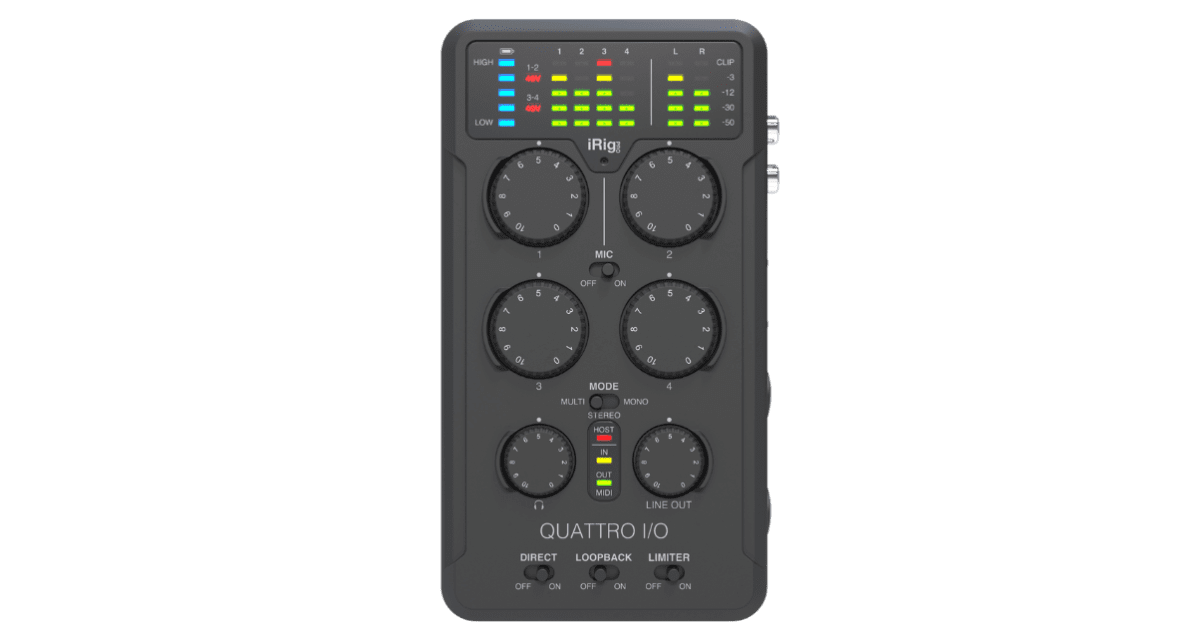The Lowdown
Once you get past the “basics” with audio interfaces, it’s really a case of deciding if the extra features on offer are the ones you need and would therefore be happy to pay the extra for. Here, having on-board mixing, Midi, a built-in microphone (and extra plug-in X-Y mic capsules available), and compatibility with iOS/Android as well as computers means the iRig Quattro I/O offers a truly portable recording interface that would also work well as a shoe-in line mixer, and for livestreamers/podcasters. But the lack of four line-level inputs and four outputs limits its use for DJs looking for a complete all-rounder.
Video Review
First Impressions / Setting up
The iRig Pro Quattro I/O is similar to the other audio interfaces in the iRig range, being rubberised dark grey plastic, but it is chunkier. It has loads of ways of inputting audio sources, with two TRS/XLR mic inputs, two more which can also be line inputs, plus 1/8″ minijack and RCA line inputs too.
There’s phantom power for using condenser mics, and while Midi is via two 2.5mm TRS sockets, IK Multimedia does provide an adaptor cable. There’s an 1/8″ minijack headphones monitor socket too, with its own level.
The version supplied for review was the basic package, but one of the things you get in the deluxe package is two microphone capsules, which make the unit look more like a little handheld recorder; of course, it is only a mixer and interface – you’ll always have to plug it into an external phone, tablet, computer etc to do the actual recording.
Power is via 4 x AA batteries, USB or an external power supply unit.
In Use
We swapped this out in our livestreaming set-up, and also in our tiny DAW-less studio, to put it through its paces.
Although it’s a “four-in” audio interface, we thought the Stereo mode, which mixes all of the input sources to a final stereo output, was super useful – this would make for easy livestreaming via standard apps, but also this way you could use it as a simple PA live mixer. This can be switched to mono if required, too.
In this way, you could buy this and have it in your gig bag to use to add microphones to a DJ controller, for instance, quite apart from its audio interface features. Of course, all channels can be routed individually via the audio interface into your phone, tablet or computer too.
Midi makes it doubly useful if you’re using it in a small home or portable studio, because it is ultimately a compact device which can do Midi alongside everything else, whereas Midi-enabled audio interfaces are usually bulkier and not designed to be portable like this. Where space is an absolute premium, it shines.
There are lots of thoughtful features for recording, with various ways of configuring input channels and the “loopback” function for flexibility when using it is a field recording interface or when producing with laptop DAWs.
Read this next: How To Record Your DJ Sets (Even When Using Streaming Services)
The rotary low-profile dials for adjusting the four inputs, the line out volume and the headphones level are a tiny bit fiddly, but they’re probably the best solution as far as durability goes.
The comprehensive per-channel VU metering with a master meter too puts many DJ controllers to shame. There’s a clear 5-bar battery meter, too.
The sound quality is great – it is a 24-bit/96kHz audio interface, the mic pre-amps sounded sweet to us, and there’s even a limiter you can switch in, which would be useful for times when you can’t trust your mic levels.
Conclusion
This is really a four-in-one device: A field recorder (although you have to add something to actually record on), a 4-in, 2-out audio interface, a simple line mixer with mic pre-amps, and a Midi interface. It does all that while being portable and battery powered.
Livestream your sets like a pro: DJ Livestreaming Made Easy
If you’re looking for one box to do all of these things, then, it’s great. For DJs who also produce and do field recordings, who like to livestream their sets, and who also sometimes wish they had a live mixer with them when setting up performances, I can think of no other device that covers all of these bases.
If only it had four outputs and line input options for the mic-only channels too, it would be a near-perfect all-in-one for DJ/producers, because you could use it with DJ software to provide separate headphones and speaker feeds, and as a DVS interface at a push, too. Sadly, neither of these things are possible with this unit.
As it is, this is a high quality, unique device. You just need to understand what it can – and can’t – do before shelling out the €350 (or €500 for the deluxe bundle). Otherwise, it’s quite a lot of money to spend on a device which may not do some of the basics you may expect at this price, and at some point need, as a DJ. Maybe it’s about time someone made the ultimate DJ interface that ticks all of these boxes, but this isn’t quite it.


